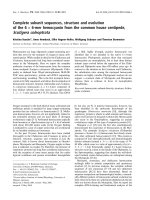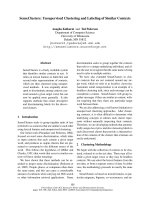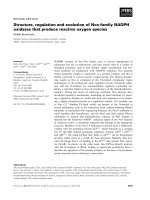Immunology and Evolution of Infectious Disease potx
Bạn đang xem bản rút gọn của tài liệu. Xem và tải ngay bản đầy đủ của tài liệu tại đây (2.16 MB, 359 trang )
Immunology
and Evolution of
Infectious Disease
STEVEN A. FRANK
Princeton University Press
Princeton and Oxford
This is a full PDF copy of:
Frank, S. A. 2002. Immunology and Evolution of Infectious Disease.
Princeton University Press.
This PDF is a trial version of the book. If you intend to read and use
the book, you should buy a copy at:
or your local bookseller.
A copy of this PDF and other information about the book is available at:
Copyright © 2002 by Steven A. Frank
Published by Princeton University Press,
41 William Street, Princeton, New Jersey 08540
In the United Kingdom: Princeton University Press,
3MarketPlace,Woodstock, Oxfordshire OX20 1SY
All Rights Reserved
Library of Congress Cataloging-in-Publication Data
Frank, Steven A., 1957–
Immunology and Evolution of Infectious Disease /
Steven A. Frank. p. cm.
Includes bibliographic references and index.
ISBN 0–691–09594–9 (cloth : alk. paper)
ISBN 0–691–09595–7 (pbk. : alk. paper)
1. Immunogenetics. 2. Host-parasite relationships—
Genetic aspects. 3. Microorganisms—Evolution.
4. Antigens. 5. Molecular evolution.
6. Parasite antigens—Variation. I. Title.
[DNLM: 1. Communicable Diseases—immunology.
2. Evolution, Molecular. 3. Genetics, Population.
4. Immunity—genetics. WC 100 F828i 2002]
QR184 .F73 2002
616.9
0479—dc21 2002018384
British Library Cataloging-in-Publication Data is available
Typeset by the author with T
E
X
Composed in Lucida Bright
Printed on acid-free paper.
∞
www.pupress.princeton.edu
Printed in the United States of America
10 9 87654321
10 9 87654321
(Pbk.)
Contents
Acknowledgments
xi
1
Introduction
3
PART I: BACKGROUND
2
Vertebrate Immunity
13
2.1
Nonspecific Immunity
14
2.2
Specific Immunity:
Antigens andEpitopes
15
2.3
BCells and Antibodies
16
2.4
TCells and MHC
19
2.5
Summary
20
3
Benefits of Antigenic Variation
22
3.1
Extend Length of Infection
23
3.2
Infect Hosts withPriorExposure
24
3.3
Infect Hosts withGenetically
Variable Resistance
26
3.4
Vary Attachment Characters
26
3.5
AntigenicInterference
28
3.6
Problems for Future Research
29
PART II: MOLECULAR PROCESSES
4
Specificity and Cross-Reactivity
33
4.1
Antigens andAntibodyEpitopes
35
4.2
Antibody Paratopes
36
4.3
Antibody Affinity Maturation
38
vi CONTENTS
4.4
Natural Antibodies—Low-Affinity
Binding toDiverseAntigens
39
4.5
Affinity versus Specificity
40
4.6
Cross-Reaction of Polyclonal
Antibodies to Divergent
Antigens
42
4.7
TCellEpitopes
44
4.8
Every Host Differs
52
4.9
Problems for Future Research
54
5
Generative Mechanisms
57
5.1
Mutation and Hypermutation
58
5.2
Stochastic Switching between
Archival Copies
61
5.3
New Variants by Intragenomic
Recombination
66
5.4
Mixing between Genomes
67
5.5
Problems for Future Research
68
PART III: INDIVIDUAL INTERACTIONS
6
Immunodominance within Hosts
73
6.1
Antibody Immunodominance
74
6.2
CTL Immunodominance
79
6.3
Sequence of Exposure to
Antigens: OriginalAntigenic Sin
87
6.4
Problems for Future Research
89
7
Parasite Escape within Hosts
93
7.1
Natural Selection of Antigenic
Variants
94
7.2
Pathogen Manipulation of Host
Immune Dynamics
97
7.3
Sequence of Variants in Active
Switching from Archives
98
CONTENTS vii
7.4
Ecological Coexistence of
Variants within a Host
102
7.5
Problems for Future Research
106
PART IV: POPULATION CONSEQUENCES
8
Genetic Variability of Hosts
111
8.1
Polymorphisms in Specificity
112
8.2
Polymorphisms in Immune
Regulation
115
8.3
Problems for Future Research
121
9
Immunological Variability of
Hosts
124
9.1
Immunological Memory
125
9.2
Kinds of Parasites
129
9.3
Immunodominance of Memory
132
9.4
Cross-Reactivity and Interference
135
9.5
Distribution of Immune Profiles
among Hosts
136
9.6
Problems for Future Research
144
10
Genetic Structure of Parasite
Populations
148
10.1
Kinds of Genetic Structure
149
10.2
Pattern and Process
151
10.3
Genome-wide Linkage
Disequilibrium
153
10.4
Antigenic Linkage Disequilibrium
164
10.5
Population Structure: Hosts as
Islands
166
10.6
Problems for Future Research
168
viii CONTENTS
PART V: STUDYING EVOLUTION
11
Classifications by Antigenicity
and Phylogeny
175
11.1
Immunological Measures of
Antigenicity
176
11.2
Phylogeny
178
11.3
Hypothetical Relations between
Immunology and Phylogeny
179
11.4
Immunology Matches Phylogeny
over Long Genetic Distances
181
11.5
Immunology-Phylogeny
Mismatch with Radiations into
New Hosts
181
11.6
Short-Term Phylogenetic
Diversification Driven by
ImmunologicalSelection
183
11.7
Discordant Patterns of
Phylogeny and Antigenicity
Created by Within-Host
Immune Pressure
183
11.8
Problems for Future Research
186
12
Experimental Evolution:
Foot-and-Mouth Disease Virus
188
12.1
Overview of Antigenicity and
Structure
189
12.2
Antibody Escape Mutants
192
12.3
Cell Binding and Tropism
196
12.4
Fitness Consequences of
Substitutions
200
12.5
Problems for Future Research
202
13
Experimental Evolution:
Influenza
205
13.1
Overview of Antigenicity and
Structure
206
13.2
Antibody Escape Mutants
214
13.3
Cell Binding and Tropism
216
CONTENTS ix
13.4
Fitness Consequences of
Substitutions
218
13.5
Experimental Evolution of Other
Pathogens
224
13.6
Problems for Future Research
227
14
Experimental Evolution: CTL
Escape
230
14.1
Cleavage and Transport of
Peptides
231
14.2
MHC Binding
232
14.3
TCR Binding
237
14.4
Functional Consequences of
Escape
239
14.5
Kinetics of Escape
240
14.6
Problems for Future Research
243
15
Measuring Selection with
Population Samples
246
15.1
Kinds of Natural Selection
247
15.2
Positive Selection to Avoid
Host Recognition
249
15.3
Phylogenetic Analysis of
Nucleotide Substitutions
251
15.4
Predicting Evolution
255
15.5
Problems for Future Research
260
16
Recap of Some Interesting
Problems
265
16.1
Population-Level Explanation for
Low Molecular Variability
265
16.2
Molecular-Level Explanation for
Population Dynamics
266
16.3
Binding Kinetics and the
Dynamics of Immunodominance
266
16.4
Diversity and Regulation of
Archival Repertoires
267
16.5
Final Note
268
x CONTENTS
References
269
Author Index
313
Subject Index
337
Acknowledgments
My wife, Robin Bush, readearlierdrafts and helped in every way. Camille
Barr provided comments on the entire manuscript. My department, led
by Chair Al Bennett, gave me the freedom to read and write over nearly
two years. The National Science Foundation and the National Institutes
of Health funded my research. My web pages at />provide information and updates for this book.
Immunology
and Evolution of
Infectious Disease
1
Introduction
Multidisciplinary has become the watchword of modern biology. Surely,
the argument goes, a biologist interested in the biochemical pathways
by which genetic variants cause disease would also want to understand
the population processes that determine the distribution of genetic vari-
ants. And how can one expect to understand the interacting parts of
complex immune responses without knowing something of the histori-
cal and adaptive processes that built the immune system?
Working in the other direction, evolutionary biologists have often
treated amino acid substitutions within a parasite lineage as simply
statistical marks to be counted and analyzed by the latest mathemat-
ical techniques. More interesting work certainly follows when hypothe-
ses about evolutionary change consider the different selective pressures
caused by antibody memory, variation among hosts in MHC genotype,
and the epidemiological contrasts between rapidly and slowly spreading
infectious diseases.
Synthesis between the details of molecular biology and the lives of
organisms in populations will proceed slowly. It is now hard enough
to keep up in one’s own field, and more difficult to follow the foreign
concepts and language of other subjects. The typical approach to syn-
thesis uses an academic discipline to focus a biological subject. I use the
biological problem of parasite variation to tie togethermanydifferent
approaches and levels of analysis.
Why should parasitevariationbethe touchstone for the integration
of disciplines in modern biology? On the practical side, infectious dis-
ease remains a major cause of morbidity and mortality. Consequently,
great research effort has been devoted to parasites and to host immune
responses that fight parasites. This has led to rapid progress in under-
standing the biology of parasites, including the molecular details about
how parasites invade hosts and escape host immune defenses. Vaccines
have followed, sometimes with spectacular success.
But many parasites escape host defense by varying their antigenic
molecules recognized by host immunity. Put another way, rapid evo-
lution of antigenic molecules all too often prevents control of parasite
4 CHAPTER 1
populations. The challenge has been to link molecular understanding
of parasite molecules to their evolutionary change and to the antigenic
variation in populations of parasites.
On the academic side, the growth of information about antigenic vari-
ation provides a special opportunity. For example, one can find in the
literature details about how single amino acid changes in parasite mol-
ecules allow escape from antibody binding, and how that escape pro-
motes the spread of variant parasites. Evolutionary studies no longer
depend on abstractions—one can pinpoint the physical basis for success
or failure and the consequences for change in populations.
Molecular understanding of host-parasite recognition leads to a com-
parative question about the forces that shape variability. Why do some
viruses escape host immunity by varying so rapidly over a few years,
whereas other viruses hardly changetheirantigens? The answer leads
to the processes that shape genetic variability and evolutionary change.
The causes of variability and change provide the basis for understanding
why simple vaccines work well against some viruses, whereas complex
vaccine strategies achieve only limited success against other viruses.
Ididnotstartout by seeking a topic for multidisciplinary synthesis.
Rather, I have long been interested in how the molecular basis of rec-
ognition between attackers and defenders sets the temporal and spatial
scale of the battle. Attack and defense occur between insects and the
plants they eat, between fungi and the crop plants they destroy, between
viruses and the bacteria they kill, between different chromosomes com-
peting for transmission through gametes, and between vertebrate hosts
and their parasites. The battle often comes down to the rates at which
attacker and defender molecules bind or evade each other. The bio-
chemical details of binding and recognition set the rules of engagement
that shape the pacing, scale, and pattern of diversity and the nature of
evolutionary change.
Of the many cases of attack and defense across all of biology, the
major parasites of humans and their domestic animals provide the most
information ranging from the molecular to the population levels. New
advances in the conceptual understanding of attack and defense will
likely rise from the facts and the puzzles of this subject. I begin by
putting the diverse, multidisciplinary facts into a coherent whole. From
that foundation, I describe new puzzles and define the key problems for
the future study of parasite variation and escape from host recognition.
INTRODUCTION 5
Istartatthe most basic level, the natureofbindingandrecognition
between host and parasite molecules. I summarize the many different
ways in which parasites generate new variants in order to escape molec-
ular recognition.
Next, I build up the individual molecular interactions into the dynam-
ics of a single infection within a host.Theparasites spread in the host,
triggering immune attack against dominant antigens. The battle within
the host develops through changes in population numbers—the num-
bers of parasites with particular antigens and the numbers of immune
cells that specifically bind to particular antigens.
Ithendiscusshow the successes and failures of different parasite
antigens within each host determine the rise and fall of parasite vari-
ants over space and time. The distribution of parasite variants sets the
immune memory profiles of differenthosts,whichinturn shape the
landscape in which parasite variants succeed or fail. These coevolution-
ary processes determine the natural selection of antigenic variants and
the course of evolution in the parasite population.
Finally, I consider different ways to study the evolution of antigenic
variation. Experimental evolution of parasites under controlled condi-
tions provides one way to study the relations between molecular rec-
ognition, the dynamics of infections within hosts, and the evolution-
ary changes in parasite antigens. Sampling of parasites from evolving
populations provides another way to test ideas about what shapes the
distribution of parasite variants.
My primary goal is to synthesize across different levels of analysis.
How do the molecular details of recognition and specificity shape the
changing patterns of variants in populations? How does the epidemio-
logical spread of parasites between hosts shape the kinds and amounts
of molecular variation in parasite antigens?
Icompare different types of parasites because comparative biology
provides insight into evolutionary process. For example, parasites that
spread rapidly and widely in host populations create a higher density of
immune memory in their hosts than do parasites that spread slowly and
sporadically. Host species that quickly replace their populations with
offspring decay their population-wide memory of antigens faster than do
host species that reproduce more slowly. How do these epidemiological
and demographic processes influence molecular variation of parasite
antigens?
6 CHAPTER 1
Iendeachchapter with a set of problems for future research. These
problems emphasize the great opportunities of modern biology. At the
molecular level, new technologies provide structural data on the three-
dimensional shape of host antibody molecules bound to parasite anti-
gens. At the population level, genomic sequencing methods provide
detailed data on the variations in parasite antigens. One can now map
the nucleotide variations of antigens and their associated amino acid
substitutions with regard to the three-dimensional location of antibody
binding. Thus, the spread of nucleotide variations in populations can
be directly associated with the changes in molecular binding that allow
escape from antibody recognition.
No other subject provides such opportunity for integrating the re-
cent progress in structural and molecular analysis with the conceptual
andmethodological advances in population dynamics and evolutionary
biology. My problems for future research at the end of each chapter
emphasize the new kinds of questions that one can ask by integrating
different levels of biological analysis.
Part I of the book gives general background. Chapter 2 summarizes
the main features of vertebrate immunity. I present enough about the
key cells and molecules so that one can understand how immune recog-
nition shapes the diversity of parasites.
Chapter 3 describesvariousbenefits that antigenic variation provides
to parasites. Thesebenefits explain why parasites vary in certain ways.
For example, antigenic variation can help to escape host immunity dur-
ing a single infection, extending the time a parasite can live within a
particular host. Or antigenic variation may avoid the immunological
memory of hosts, allowing the variant to spread in a population that
previously encountered a different variant of that parasite. Different
benefits favor different patterns of antigenic variation.
Part II introduces molecular processes. Chapter 4 describes the at-
tributes of host and parasite molecules that contribute to immune rec-
ognition. The nature of recognition depends on specificity, the degree
to which the immune system distinguishes between different antigens.
Sometimes two different antigens bind to the same immune receptors,
perhaps with different binding strength. This cross-reactivity protects
INTRODUCTION 7
hosts against certain antigenic variants, and sets the molecular dis-
tance by which antigenic types must vary to escape recognition. Cross-
reactivity may also interfere with immune recognition when immune
receptors bind a variant sufficientlytopreventanewresponse but not
strongly enough to clear the variant.
Chapter 5 summarizes the different ways in which parasites gener-
ate antigenic variants. Many parasites generate variants by the stan-
dard process of rare mutations during replication. Baseline mutation
rates vary greatly, from about 10
−5
per nucleotide per generation for
the small genomes of some RNA viruses to about 10
−11
for larger ge-
nomes. Although mutations occur rarely at any particular site during
replication, large populations generatesignificant numbers of mutations
in each generation. Some parasites focus hypermutation directly on
antigenic loci. Other parasites store within each genome many genetic
variants for an antigenic molecule. These parasites express only one
genetic variant at a time and use specialized molecular mechanisms to
switch gene expression between the variants.
Part III focuses on the dynamics of a single infection within a par-
ticular host. Chapter 6 emphasizes the host side, describing how the
immune response develops strongly against only a fewofthemany dif-
ferent antigens that occur in each parasite. This immunodominance
arises from interactions between the populations of immune cells with
different recognition specificities and the population of parasites within
the host. Immunodominance determines which parasite antigens face
strong pressure from natural selection and therefore which antigens are
likely to vary over space and time. To understand immunodominance, I
step through the dynamic processes that regulate an immune response
and determine which recognition specificities become amplified.
Chapter 7 considers the ways in whichparasites escape recognition
during an infection and the consequences for antigenic diversity within
hosts. The chapter begins with the role of escape by mutation in persis-
tent infections by HIV and hepatitis C virus. I then discuss how other
parasites extend infection by switching gene expression between vari-
ants stored within each genome. This switching leads to interesting
population dynamics within the host. The different variants rise and
fall in abundance according to the rate of switching between variants,
the time lag in the expansion of parasite lineages expressing a particular
variant, and the time laginthehost immune response to each variant.
8 CHAPTER 1
Part IV examines variability in hosts and parasites across entire pop-
ulations. Chapter 8 considers genetic differences among hosts in im-
mune response. Hosts differ widely intheirmajorhistocompatibility
complex (MHC) alleles, which cause different hosts to recognize and fo-
cus their immune responses on different parasite antigens. This host
variability can strongly affect the relative success of antigenic variants
as they attempt to spread from host to host. Hosts also differ in mi-
nor ways in other genetic components of specific recognition. Finally,
host polymorphisms occur in the regulation of the immune response.
These quantitative differences in the timing and intensity of immune
reactions provide an interesting modelsystemforstudying the genetics
of regulatory control.
Chapter 9 describes differences among hosts in their molecular mem-
ory of antigens. Each host typically retains the ability to respond quickly
to antigens that it encountered in prior infections. This memory pro-
tects the host against reinfection by the same antigens, but not against
antigenic variants that escape recognition. Each host has a particular
memory profile based on past infections. The distribution of memory
profiles in the host population determines the ability of particular anti-
genic variants to spread between hosts. Hosts retain different kinds of
immunological memory (antibody versus T cell), which affect different
kinds of parasites in distinct ways.
Chapter 10 reviews the genetic structure of parasite populations. The
genetic structure of nonantigenic loci provides information about the
spatial distribution of genetic variability, the mixing of parasite lineages
by transmission between hosts, andthemixing of genomes by sexual
processes. The genetic structure ofantigenic loci can additionally be
affected by the distribution of host immunological memory, because
parasites must avoid the antigen sets stored in immunological memory.
Host selection on antigenic sets could potentially structure the parasite
population into distinct antigenic strains. Finally, each host forms a
separate island that divides the parasite population from other islands
(hosts). This island structuring of parasite populations can limit the
exchange of parasite genes by sexual processes, causing a highly inbred
structure. Island structuring also means that each host receives a small
andstochastically variable sample of the parasite population. Stochastic
fluctuations may play an important role in the spatial distribution of
antigenic variation.
INTRODUCTION 9
Part V considers different methods to study the evolutionary pro-
cesses that shape antigenic variation. Chapter 11 contrasts two differ-
entwaystoclassify parasite variants sampled from populations. Im-
munological assays compare the binding of parasite isolates to differ-
ent immune molecules. The reactions of each isolate with each immune
specificity form a matrix from which one can classify antigenic variants
according to the degree to which theysharerecognition by immunity.
Alternatively, one can classify isolates phylogenetically, that is, by time
since divergence from a common ancestor. Concordant immunological
and phylogenetic classifications frequently arise because immunological
distance often increases with time since a common ancestor, reflecting
the natural tendency for similarity by common descent. Discordant pat-
terns of immunological and phylogenetic classifications indicate some
evolutionary pressure on antigens that distorts immunological similar-
ity. I show how various concordant and discordant relations point to
particular hypotheses about the natural selection of antigenic proper-
ties in influenza and HIV.
Chapter 12 introduces experimental evolution, a controlled method to
test hypotheses about the natural selection of antigenic diversity. This
chapter focuses on foot-and-mouth disease virus.Thiswell-studied vi-
rus illustrates how one can measure multiple selective forces on partic-
ular amino acids. Selective forces on amino acids in viral surface mole-
cules include altered binding to host-cell receptors and changed binding
to host antibodies. The selective forces imposed by antibodies and by at-
tachment to host-cell receptors can be varied in experimental evolution
studies to test their effects on aminoacidchange in the parasite. The
amino acid substitutions can also bemapped onto three-dimensional
structural models of the virus to analyze how particular changes alter
binding properties.
Chapter 13 continues with experimental evolution of influenza A vi-
ruses. Experimental evolution has shown how altering the host species
favors specific amino acid changes intheinfluenzasurface protein that
binds to host cells. Experimental manipulation of host-cell receptors
and antibody pressure can be combined with structural data to under-
stand selection on the viral surface amino acids. These mechanistic
analyses of selection can be combined with observations on evolution-
arychange in natural populations to gain a better understanding of how
selection shapes the observed patterns of antigenic variation.
10 CHAPTER 1
Chapter 14 discusses experimental evolution of antigenic escape from
host T cells. The host T cells can potentially bind to any short peptide
of an intracellular parasite, whereas antibodies typically bind only to
the surface molecules of parasites. T cell binding to parasite peptides
depends on a sequence of steps by which hosts cut up parasite proteins
and present the resulting peptides on the surfaces of host cells. Para-
site escape from T cell recognition can occur at any of the processing
steps, including the digestion of proteins, the transport of peptides, the
binding of peptides by the highly specific host MHC molecules, and the
binding of peptide-MHC complexes to receptors on the T cells. One or
two amino acid substitutions in a parasite protein can often abrogate
binding to MHC molecules or to the T cell receptors. Experimental evo-
lution has helped us to understand escape from T cells because many
of the steps can be controlled, such as the MHC alleles carried by the
host and the specificities of the T cell receptors. Parasite proteins may
be shaped by opposing pressures on physiological performance and es-
cape from recognition.
Chapter 15 turns to samples of nucleotide sequences from natural
populations. A phylogenetic classification of sequences provides a his-
torical reconstruction of evolutionary relatedness and descent. Against
the backdrop of ancestry, one can measure how natural selection has
changed particular attributes of parasite antigens. For example, one can
study whether selection caused particular amino acids to change rapidly
or slowly. The rates of change for particular amino acids can be com-
pared with the three-dimensional structural location of the amino acid
site, the effects on immunological recognition, and the consequences
for binding to host cells. The changes in natural populations can also
be compared with patterns of change in experimental evolution, in which
one controls particular selective forces. Past evolutionary change in pop-
ulation samples may be used to predict which amino acid variants in
antigens are likely to spread in the future.
The last chapter recaps some interesting problems for future research
that highlight the potential to study parasites across multiple levels of
analysis.
PART I
BACKGROUND
2
Vertebrate
Immunity
“The CTLs destroy host cells when their TCRs bind matching MHC-pep-
tide complexes.” This sort of jargon-filled sentence dominates discus-
sions of the immune response to parasites. I had initially intended this
book to avoid such jargon, so that any reasonably trained biologist could
read any chapter without getting caught up in technical terms. I failed—
the quoted sentence comes from a later section in this chapter.
The vertebrate immune system has many specialized cells and mole-
cules that interact in particular ways. One has to talk about those cells
and molecules, which means that they must be named. I could have
tried a simpler or more logically organized naming system, but then I
would have created a private language that does not match the rest of
the literature. Thus, I use the standard technical terms.
In this chapter, I introduce the major features of immunity shared by
vertebrates. I present enough about the key cells and molecules so that
one can understand how immune recognition shapes the diversity of
parasites. I have not attempted a complete introduction to immunology,
because many excellent ones already exist. I recommend starting with
Sompayrac’s (1999) How the Immune System Works,whichisashort,
wonderfully written primer. One should keep a good textbook by one’s
side—I particularly like Janeway et al. (1999). Mims’s texts also pro-
vide good background because they describe immunology in relation to
parasite biology (Mims et al. 1998, 2001).
The first section of this chapter describes nonspecific components of
immunity. Nonspecific recognition depends on generic signals of par-
asites such as common polysaccharides in bacterial cell walls. These
signals trigger various killing mechanisms, including the complement
system, which punches holes in the membranes of invading cells, and
the phagocytes, which engulf invaders.
The second section introduces specific immunity, the recognition of
small regions on particular parasite molecules. Specific recognition oc-
curs when molecules of the host immune system bind to a molecular
shape on the parasite that is not shared by other parasites. Sometimes
all parasites of the same species share the specificity, and recognition
14 CHAPTER 2
differentiates between different kindsofparasites. Other times, differ-
ent parasite genotypes vary in molecular shape, so that the host mole-
cules that bind specifically to one parasite molecule do not bind another
parasite molecule that differs by as little as one amino acid. A parasite
molecule that stimulates specific recognition is called an antigen. The
small region of the parasite molecule recognized by the host is called
an epitope. Antigenic variation occurs when a specific immune response
against one antigenic molecule fails to recognize a variant antigenic mol-
ecule.
The third section presents the B cells, which secrete antibodies. An-
tibodies are globular proteins thatfightinfectionbybinding to small
regions (epitopes) on the surface molecules of parasites. Different an-
tibodies bind to different epitopes. An individual can make billions of
different antibodies, each with different binding specificity. Diverse an-
tibodies provide recognition and defense against different kinds of par-
asites, and against particular parasites that vary genetically in the struc-
ture of their surface molecules. Antibodies bind to surface molecules
and helptoclearparasitesoutside of host cells.
The fourth section focuses on specific recognition by the T cells. Host
cells continually break up intracellular proteins into small peptides. The
hosts’ major histocompatibility complex (MHC) molecules bind short
peptides in the cell. The cell then transports the bound peptide-MHC
pair to the cell surface for presentation to roving T cells. Each T cell
has receptors that can bind only to particular peptide-MHC combina-
tions presented on the surface of cells. Different T cell clones produce
different receptors. When a T cell binds to a peptide-MHC complex on
the cell surface and also receives stimulatory signals suggesting para-
site invasion, the T cell can trigger the death of the infected cell. T cells
bind to parasite peptides digested in infected cells and presented on the
infected cell’s surface, helping to clear intracellular infections.
The final section summarizes the roles of antibodies and T cells in
specific immunity.
2.1 Nonspecific Immunity
Nonspecific immunity recognizes parasites by generic signs that in-
dicate the parasite is an invader rather than a part of the host. The
nonspecific complement system consists of different proteins that work









